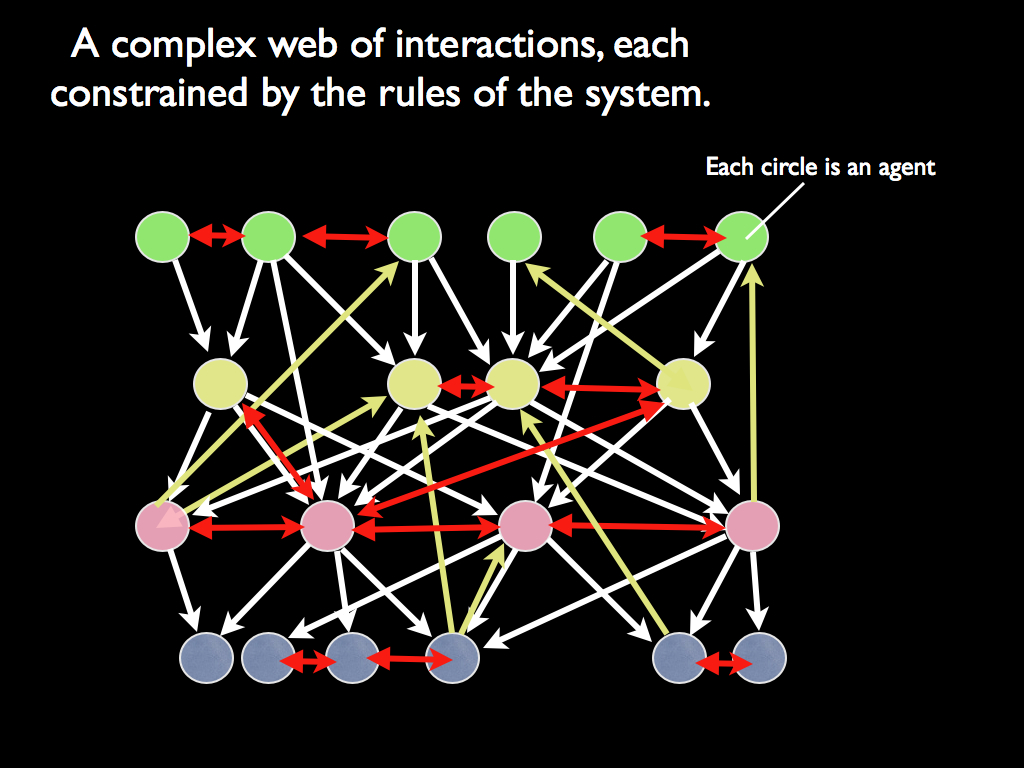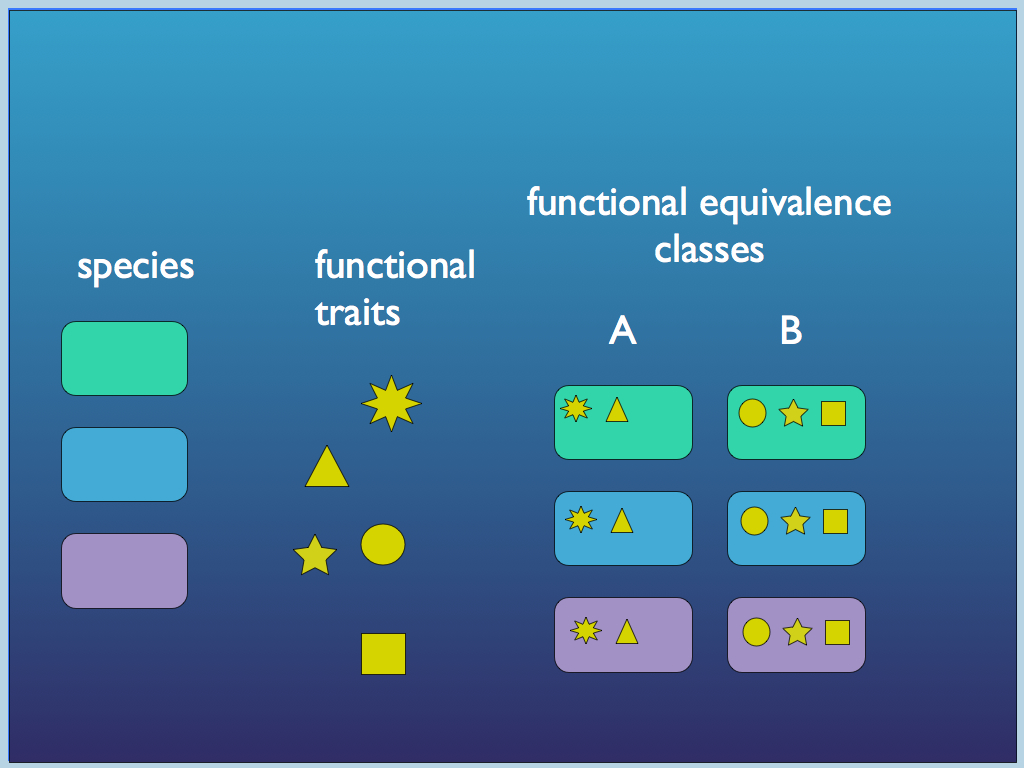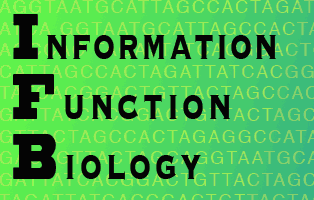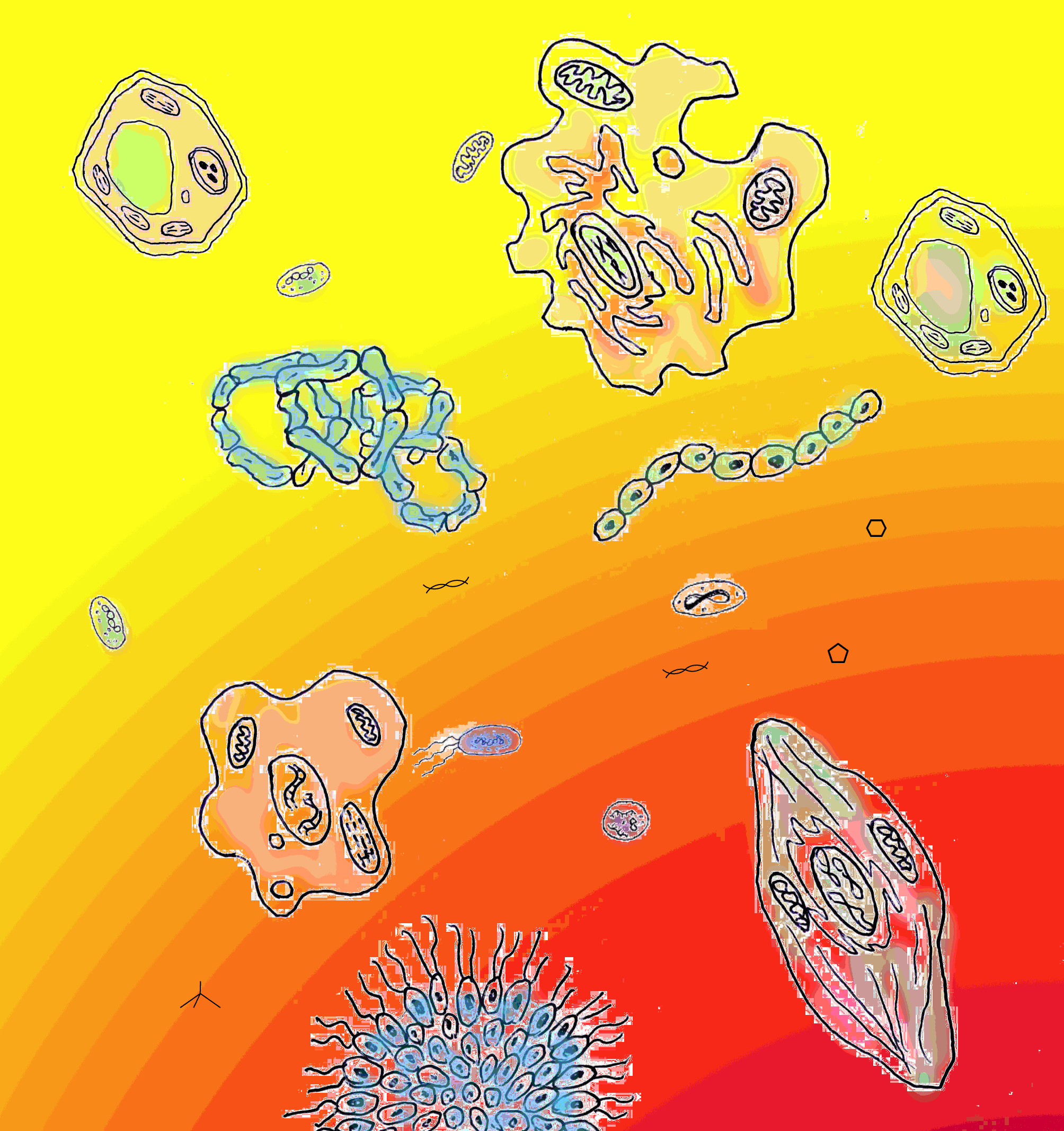Transcendent Complexes, Information
and
Emergence
This article was rewritten by Keith Farnsworth in January 2019, updated in January 2020.
Note, the interpretation of information itself as a TC phenomenon has been removed. It will be dealt with in another page in greater depth (as soon as KF gets round to that).
(Note: this page is intended for reading alongside Downward Causation).
Here I explain what I mean by a 'transcendent complex' and elaborate on the information approach to emergence, with special reference to life. In the shortest and simplest of terms, a transcendent complex is pure information that is embodied at the whole system level and which is capable of exercising downward causation on its subsystem constituents.
What is a transcendent complex?
The national economy goes through cycles of fluctuating income,
debt, employment rates and so on, but this is all really the
consequence of millions of individual trading transactions
aggregated. It is an emergent phenomenon
that arises from an
interaction network: from the transactions not the agents doing the
transacting. But, we
all know that this phenomenon has some influence on the behaviour of
the agents that, by their collective actions, bring the economy into
being. People's economic behaviour is at least influenced (if not
governed) by the economy through which they interact. Indeed, I
remember the very clear change in Russian people's behaviour when the
Soviet empire collapsed: they became more selfish (we might speculate
this is because the economy in which they were enmeshed changed from
one in which everyone got what they were given to one in which a person
only got what they traded for, or took). It might be thought that the
Soviet economy was designed and caused by the command of bureaucrat
decision makers, but it was far too complicated for that. The real
economy of Russia in Soviet times was, like all economies, a complex
system of interactions among people: the role of those bureaucrats was
only to set the rules for which kinds of interactions were permitted
(and in any economy it is the same - all that differs among them is the
set of rules for interactions). All economies are emergent phenomena
that arise from interactions: they are not made as a machine is made,
they appear as clouds appear from water droplets. For all that,
economies, immaterial emergent phenomena though they be, influence the
behaviour of the very agents who's behaviour determines their nature.
This is just an example, of course, but we can already see that,
perhaps weirdly, an immaterial thing can be
responsible for its own nature. 
That is not all, because the economy does not depend on the agents themselves, but only their transactional behaviours. It does not matter if Jack and Jill or Ivan and Olga are interacting, as long as their interactions follow the rules for economy A, then economy A is what emerges and our pair of protagonists interact in the way that economy A influences them to do so. For this reason, the economy transcends the people who bring it forth, it is independent of their personal identity and yet it is still only an emergent phenomenon, with no material substance, wholly dependent on their interactions. In fact, it is purely informational: nothing more than the sum of the interactions, which are really just a summary of who has what, or gives it to whom.
For these reasons, an economy is a transcendent complexof the trading transactions which collectively constitute it. It is transcendent because it does not depend on its component parts, only on their interactions and it is complex because it emerges from a complex system: in this it is a special case of an emergent phenomenon.
Similarly, the former UK Prime Minister, Margaret Thatcher is famous for having said (though she did not quite) that "there is no such thing as society, there are just individual people". She may have been expressing a view on 'emergence' in complex systems, had she not been attacking socialism. In material terms, she was right - there really are only individual people and what we call 'society' is an emergent phenomenon, rather than a material thing. It emerges from the aggregated effect of interactions among the people taking part. And it exists as an informational structure because the interactions are not random, but in some way organised, which is to say of lower entropy than if they were random and therefore instantiating information. This information, which we recognise as 'society' influences the behaviour of its members, and it does not depend on exactly who takes part in it: to this extent society transcends its component parts. As an information (cybernetic) structure, it has properties that we can describe, measure and predict with models. These properties are termed 'emergent' because they only exist at a level of organisation above that of the components (the people) that create it through their interactions.
Functional Equivalence
Whenever an emergent phenomenon is independent of the identity of its component parts - strictly only depending on their relevant behaviours - and is responsible for influencing the behaviour of those component parts, then it can be called a transcendent phenomenon. The component parts are effectively substitutable, what matters is only that they behave (and especially that they interact) the right way: that is, they must have the correct functions. In principle there is a whole class of potential components sharing in common the correct functions and this class is the Functional Equivalence Class (FEC).

The diagram above illustrates a very good example of functional equivalence in an ecological community, especially well worked out for a microbial community such as that found in the gut of an animal. The modern idea of, e.g. microbes, in such a system is that the individual organism of a particular species is really just a sort of biological 'container' for a set of functional 'tools' that give it the capacity to perform given functions. This is achieved through adding functional traits, each based on DNA that codes for the component parts (proteins) and the regulaion of their behaviour (a more or less complex network of gene-protein interactions). The information specifying the traits is effectively an optional package added onto the basic operating system of the cell (that which enables it to live). Thus, in a typical microbial community, each cell of a given species performs several functions, but each of these functions is performed by several different species. Any particular set of functional traits in any species is a functional equivalence class, because it no longer matters which species is present in the community, as long as it is one with the right set of traits (that is, as long as it is a member of the FEC). This idea is elaborated on our function page.
Some examples
Because we can make a conceptual (e.g. computer based) model of, for example, an ecosystem which (mostly) displays the same emergent phenomena as the real thing, we suspect that there is something about the ecosystem that does not strictly depend on the material (organisms) underlying it. In other words, there seems to be an informational structure embodied in the interactions, but it is hard to see. More obviously, a computer program such as a word-processor, is an observable phenomenon at a scale of organisation greater than the binary bits of data from which it is composed and it could in principle be implemented, not only in any digital electronic computer, but also in hardware composed of mechanical valves and tubes of water, i.e. digital plumbing (and this really has been done - the UK treasury model of the economy was for a long time just such a 'water computer' and, when one day I sat beside a senior economist in Oxford University, he told me with glee that it still exists and is still useful!).
The Turing machine is a fundamental concept in computer science: it is a conceptual machine that can in principle compute anything that is computable. So when a Turing machine was created using the plastic building toy ‘Lego’, it became possible, in principle, to make the word-processor from Lego. Clearly a word-processor is a phenomenon that is not determined by what it is made from.
The difference between a transcendent complex (TC) and a mere 'emergent phenomenon' is that the TC is functional in the sense that it executes a process which arises from the organised functional actions of its components. In other words, a TCs components have functions, which when combined in the way that is determined by the TC, collectively produce a higher level function: one that is a property of the higher ontological level to which the TC belongs. So, we can, for example, describe the 'function of the economy', or ecosystem function. This idea is closely related to the IFB definition of biological function (A biological function is a process enacted by a biological system A at emergent level N which influences one or more processes of a system B at level N+1, of which A is a component part - Farnsworth et al 2017).
We shall use the term ‘transcendent complex’ (TC for short) for such entities because they transcend the particular method of implementation used. Their properties are that (a) they arises from the interaction among elements and (b) they may be realised (i.e. instantiated) in multiple ways, because they depend only on certain functions of the elements, not their whole nature. TCs are therefore multiply realisable, which is the concept used to define classes of functional equivalence in the hierarchical structure of cellular chemistry (Auletta et al (2008); Jaeger & Calkins (2012)).
It is important, so I will emphasise that a TC is pure information: a cybernetic phenomenon. The information is embodied as the organisational structure of the system level (N+1), together with the functional (only) specification of the functional components (where it is embodied in each at level N).
Elements within an ensemble do not really interact with the TC of that ensemble, they only interact with each other. What makes the interactions act as something larger controlling the behaviour of the elements (see downward causation), is the additional functionality provided by the particular configuration that gives rise to the TC. The configuration of the ensemble is one that instantiates functional information so that a TC emerges. The TC is the aggregate of this functional information and it appears at the scale of organisation of the ensemble. It is the difference between a pile of jigsaw pieces and the completed puzzle. The relationship between one piece and the others in the pile is random and without function; that between one piece and the rest of the completed puzzle is special because the piece has a specific place in the configuration. The other pieces give it context: the information which it embodies ‘makes sense’ when placed in this context. ‘Makes sense’ here means that the embodied information of the piece forms part of a functional information pattern at the larger scale, once the other pieces are in the functional configuration. It is this functional pattern that is the TC. For a swarm (a flock of birds or shoal of fish) the functional configuration is the ordering of animals at specific distances and orientations (see e.g. Aoki, 1982). In this pattern, the (translational) movement of any one of them is highly correlated with the others. It forms part of a pattern built at a higher level of organisation and that pattern is functional and its function is one of causal power - the power to direct the movements of the animals. This causal power is implemented through the efficient cause of neighbouring animals, but the causal power clearly arises at the higher level of organisation because it equally applies to all of the animals in the swarm.
Functional equivalence classes and emergence
The behaviour of assemblies of components, such as molecules in a gas, are conveniently described by averages taken over the assembly: what physicists refer to as 'course graining'. However, these averages are often not seen as simply that, but as new and apparently separate phenomena in their own right - for example pressure and temperature, which are based on the average of kinetic energies of molecules. We would interpret this by saying that phenomena at a given level of organisation (e.g. molecules) can produce effective higher level variables, so creating a higher level of organisation, reminding us that the new phenomena are really just a way to think of what is happening at a grander scale. If we start with a coarse-grained (effective) view at some level, we are denied information about the details at the fine-grained level below. For this reason, many possible states at the lower level may be responsible for what we see at the higher (which is exactly the micro-state / macro-state relationship used in statistical thermodynamics). There are, therefore, multiple realisations of any higher-level phenomenon, based on multiple micro-state configurations (many ways to get the same average from a set of numbers). The multiple ways of realising a single higher level phenomenon can be collected together as a class of functional equivalence: a set of states, configurations, or realisations at the lower level, which all produce an identical phenomenon at the higher. A functional equivalence class is by definition the ensemble of entities sharing in common that they perform some defined function. But a phenomenon can only be functional in a particular context, since function is always context dependent (Cummins, 1975). This context is provided by the TC, which organises one or more of the members of one or more functional equivalence classes into an integrated whole having ‘emergent properties’. The TC is an information structure composed of the interactions among its components. In practice, these make up the material body, which embodies the information that collectively constitutes the TC. It must be described in terms of functional equivalence classes because it is multiply realisable. Crucially, the TC does not integrate the lower level components per se, it integrates their effects, so the TC emerges from functional equivalence classes, not from the particular structures or states that constitute their members. Specifically, a TC is the multiply realisable information structure that gives lower level structures the context for their actions to become functional. It is an aggregate phenomenon of functions. For it to exist, a set of components must be interacting to perform these functions; the components must collectively be members of the necessary functional equivalence classes. TCs are the special case of emergent phenomena: TCs are those that are functional.How (intangible) information can control (tangible) material
Invoking TCs as the means by which higher level structures gain function from the information-based constraint of their component parts, we appear to be allowing intangible information to have causal effect over tangible material and at first sight, that seems odd. Sarah Walker (2012) calls this “the hard problem of life”, in an echo of “the hard problem of consciousness”. The conundrum is, how can information (which is taken to be insubstantial and non-physical) influence the physical world. This is an important question because it seems that all cases of identified life (and also mimicry of it as artificial and hypothetical life) have in common the feature of information appearing to control aspects of the physical world. In the language we use on this website, that translates to the ‘transcendent phenomenon of information’ apparently directing behaviours at lower levels of organisation in matter and energy. Now we ask: is this really possible?
The answer lies in the definition of formal cause, since we have only said that the information making a TC acts on material by constraining the action of physical forces through determining the location of their subject and object in time and space. What physically happens is the result of efficient cause, but this is always the result of formal cause constraining physical forces. According to our founding axiom: that reality is composed of matter / energy distributed in space / time by embodied information so that physical forces (the motive relationships between elementary particles) always produce outcomes that are particular to the information, all of reality is formally determined by information. Without constraining information, the whole universe would be a 'gray soup' of particles and photons moving at random, having no larger scale structure at all. So the question of how, at some scale of complexity, information appears to gain causal power, never arises. Information has causal power at every scale of organisation, because it is the source of formal cause. This means that TCs are hypothetically possible at any level of natural organisation above the most elementary one. It is also noteworthy that many well informed commentators (Ellis included) say that we do not yet know what level N=1 is, so all known levels of natural organisation are potentially available for top-down causation.
A recurring theme on these webpages is the appearance of self-referencing (impredicative) problems and systems (see all the references to Robert Rosen's work for instance). These logical loops seem to characterise nature as we currently understand it. I cannot help noticing that the very essence of information is also of this form: it requires material to exist, but by existing, in the configuration of material, it causes that material to give rise to itself. This seems impossible: the ultimate chicken and egg problem. But we know it is not impossible, because it is here and we are made of it (I am impredicative, therefore I am). What we need is a radically new way of thinking to enable us to conceptually grasp it. There are some hints of this in the work by Rashevsky and Rosen and Louie and others using category theory, but we still have some way to go in my opinion. One thing is certain, though: we are never going to be able to understand this sort of thing using the sequential algorithmic thinking of strictly empirical science.
References
Aoki I. (1982). A simulation study on the schooling mechanism in fish. Bull. Jpn. Soc. Sci. Fish. 48:1081–1088.
Auletta, G.; Ellis, G.; Jaeger, L. (2008). Top-down causation by information control: From a philosophical problem to a scientific research programme. J. R. Soc. Interface, 5, 1159–1172.
Cummins, R. (1975). Functional analysis. J. Philos., 72(20):741–765.
Farnsworth, K.D.; Albantakis, L.; Caruso, T. (2017). Unifying concepts of biological function from molecules to ecosystems. Oikos, doi: 10.1111/oik.04171.
Jaeger, L., Calkins, E. (2012). Downward causation by information control in micro-organisms. Interface Focus, 2, 26-41.

